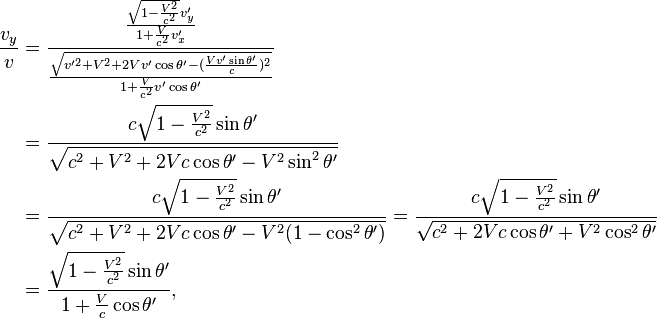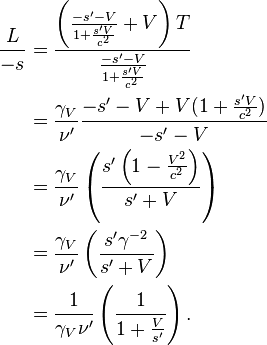Velocity-addition formula
In relativistic physics, a velocity-addition formula is a 3-dimensional equation that relates the velocities of objects in different reference frames. Such formulas apply to successive Lorentz transformations, so they also relate different frames. Accompanying velocity addition is a kinematic effect known as Thomas precession, whereby successive non-collinear Lorentz boosts become equivalent to the composition of a rotation of the coordinate system and a boost.
Standard applications of velocity-addition formulas include the Doppler shift, Doppler navigation, the aberration of light, and the dragging of light in moving water observed in the 1851 Fizeau experiment.[1]
History
The speed of light in the fluid is slower than the speed of light in vacuum, and it changes if the fluid is moving along with the light. In 1851, Fizeau measured the speed of light in a fluid moving parallel to the light using a Michelson interferometer. Fizeau's results were not in accord with the then prevalent theories. Fizeau experimentally correctly determined the zeroth term of an expansion of the relativistically correct addition law in terms of V⁄c as is described below. Fizeau's result led physicists to accept the empirical validity of the rather unsatisfactory theory by Fresnel that a fluid moving with respect to the stationary aether partially drags light with it, i.e. the speed is c + (1 - 1⁄n2)V instead of c + V, where c is the speed of light in the aether, and V is the speed of the fluid with respect to the aether.
The aberration of light, of which the easiest explanation is the relativistic velocity addition formula, together with Fizeau's result, triggered the development of theories like Lorentz aether theory of electromagnetism in 1892. It was only with the advent of special relativity in 1905 that the issues involving aether were, gradually over the years, settled.
Galilean relativity
It was observed by Galileo that a person on a uniformly moving ship has the impression of being at rest and sees a heavy body falling vertically downward.[2] Galileo saw that from the point of view of a person standing on the shore, the motion of falling downwards on the ship would be combined with, or added to, the forward motion of the ship.[3] So that in terms of velocities it can be said that the velocity of the falling body relative to shore equals the velocity of that body relative to ship plus the velocity of the ship relative to the shore.
In general for three objects A, B, C the velocity of C relative to A is the sum of the velocity of C relative to B plus the velocity of B relative to A. The addition here is the vector addition of vector algebra and the resulting velocity is usually represented in the form
In classical mechanics vectors : may be referred (using equipollence) to .the same origin and usually are. But by definition they are relative velocities starting from different origins. This point is important in the generalization to Special Relativity where equipollence does not apply in general.
may be referred (using equipollence) to .the same origin and usually are. But by definition they are relative velocities starting from different origins. This point is important in the generalization to Special Relativity where equipollence does not apply in general.
The cosmos of Galileo consists of absolute space and time and the addition of velocities corresponds to composition of Galilean transformations.
Special relativity
According to the theory of special relativity, the frame of the ship has a different clock rate and distance measure, and the notion of simultaneity in the direction of motion is altered, so the addition law for velocities is changed. This change is not noticeable at low velocities but as the velocity increases towards the speed of light it becomes important. The addition law is also called a composition law for velocities. For collinear motions, the velocity of the fly relative to the shore is given by
The composition formula can take an algebraically equivalent form, which can be easily derived by using only the principle of constancy of the speed of light:[4]
Standard configuration
The formulas for boosts in the standard configuration follow most straightforwardly from taking differentials of the inverse Lorentz boost in standard configuration,.[5][6] If the 'primed' frame is travelling with velocity  in the positive
in the positive  direction relative to the 'unprimed' frame then the formulas are
direction relative to the 'unprimed' frame then the formulas are
Divide the first three equations by the fourth,
or
which is
Transformation of velocity (Cartesian components)
If coordinates are chosen so that all velocities lie in a (common) x-y plane, then velocities may be expressed as
(see polar coordinates) and one finds[7]
Transformation of velocity (Plane polar components)
The proof as given is highly formal. There are other more involved proofs that may be more enlightening, such as the one below.
Since a relativistic transformation rotates space and time into each other much as geometric rotations in the plane rotate the x- and y-axes, it is convenient to use the same units for space and time, otherwise a unit conversion factor appears throughout relativistic formulae, being the speed of light. In a system where lengths and times are measured in the same units, the speed of light is dimensionless and equal to 1. A velocity is then expressed as fraction of the speed of light.
To find the relativistic transformation law, it is useful to introduce the four-velocities V = (V0, V1, 0, 0) and U = (U0, U1, U2, U3). The four-velocity is defined to be a four-vector with relativistic length equal to 1, future-directed and tangent to the world line of the object in spacetime. Here, V0 corresponds to the time component and V1 to the x component of the fly's four-velocity as seen by the ship. It is convenient to take the x-axis to be the direction of motion of the ship, and the y-axis so that the x–y plane is the plane spanned by the motion of the ship and the fly. This results in several components of the velocities being zero; V2 = V3 = U3 = 0.
The ordinary velocity is the ratio of the rate at which the space coordinates are increasing to the rate at which the time coordinate is increasing,
Since the relativistic length of V is 1,
so
The Lorentz transformation matrix that boosts the rest frame to four-velocity V is then
This matrix rotates the a pure time-axis vector (1, 0, 0, 0) to (V0, V1, 0, 0), and all its columns are relativistically orthogonal to one another, so it defines a Lorentz transformation.
If a fly is moving with four-velocity U in the rest frame, and it is boosted by multiplying by the matrix above, the new four-velocity is S = (S0, S1, S2, S3),
Dividing by the time component S0 and substituting for the components of the four-vectors U and V in terms of the components of the three-vectors u and v gives the relativistic composition law as
The form of the relativistic composition law can be understood as an effect of the failure of simultaneity at a distance. For the parallel component, the time dilation decreases the speed, the length contraction increases it, and the two effects cancel out. The failure of simultaneity means that the fly is changing simultaneity slices as the projection of u onto v. Since this effect is entirely due to the time slicing, the same factor multiplies the perpendicular component, but for the perpendicular component there is no length contraction, so the time dilation multiplies by a factor of 1⁄V0 = √(1 − v12).
General configuration

Starting from the expression in coordinates for V parallel to the x-axis, expressions for the perpendicular and parallel components can be cast in vector form as follows, a trick which also works for Lorentz transformations of other 3d physical quantities originally in set up standard configuration. Introduce the velocity vector v in the unprimed frame and v′ in the primed frame, and split them into components parallel ( ∥ ) and perpendicular (⊥) to the relative velocity vector V thus
then with the usual Cartesian unit basis vectors ex, ey, ez, set the velocity in the unprimed frame to be
which gives
where · is the dot product. Since these are vector equations, they still have the same form for V in any direction. The only difference from the coordinate expressions is that the above expressions refers to vectors, not components.
Either the parallel or the perpendicular component for each vector needs to be found, since the other component will be eliminated by substitution of the full vectors.
The parallel component of v′ can be found by projecting the full vector into the direction of the relative motion
and the perpendicular component of v′ can be found by the geometric properties of the cross product (see figure on right),
In each case, V/V is a unit vector in the direction of relative motion.
The expressions for v|| and v⊥ can be found in the same way. Substituting the parallel component into
results in the above equation.[8]
The transformation of velocities relates the velocity as measured in two inertial frames, one frame F′ moves with velocity V relative to F. The velocities v and v′ could represent the constant velocity of some massive object, or a third inertial frame (say F′′), in any case denote this entity by X. Then X moves with velocity v relative to F, or equivalently with velocity v′ relative to F′, in turn F′ moves with velocity V relative to F. This can motivate the notation and definition
where αV = 1/γV is the reciprocal of the Lorentz factor. The ordering of operands in the definition is chosen to reflect the ordering of the addition of velocities, first V (the velocity of F′ relative to F) then v′ (the velocity of X relative to F′) to obtain v = V ⊕ v′ (the velocity of X relative to F).
In order to facilitate generalization and to avoid proliferation of primes, change notation of V to u, and v′ to v. Define the relativistic addition of the new u and v by the above formula,[9][nb 1]
where the last expression is by the standard vector analysis formula u × (u × v) = (u ⋅ v)u − (u ⋅ u)v, and the due to the cross products it is only true in three spatial dimensions. The first expression extends to any number of spatial dimensions.
Properties
The relativistic addition of 3-velocities is non-linear
for any real numbers λ and μ, although it is true that
Also, due to the last terms, is in general neither commutative
nor associative[10]
Nipping the bud, if u and v refer to boost velocities, then both u ⊕ v, and v ⊕ u are correct expressions for the combined boost velocity. They are just given in different coordinate systems, the unprimed and the (would be) doubly primed respectively in the old notation, related by a rotation per below. This is the phenomenon of Thomas precession.
The norm is given by[11]
It is clear that the non-commutativity manifests itself as an additional rotation of the coordinate frame when two boosts are involved, since the norm squared is the same for both orders of boosts.
The gamma factor for the combined velocity is computed as
Despite the nonlinearity in the velocity addition, it is possible to obtain the composition of the beta vectors βu = u/c and βv = v/c, which are simply proportional to the relative velocities. Defining βu⊕βv = (u⊕v)/c, it follows
Conventions
Notations and conventions for the velocity addition vary from author to author. Different symbols may be used for the operation, and the operands may be switched for the same expression. Since the velocity addition is non-commutative, we cannot naïvely switch the operands without changing the result.
- Left-to-right ordering of operands
Mocanu (1986, 1992) is used in this article,
Ungar (1988, 1989)
- Right-to-left ordering of operands
Sexl & Urbantke (1992)
Applications
Fizeau experiment

When light propagates in a medium, its speed is reduced, in the rest frame of the medium, to cm = c⁄nm, where nm is the index of refraction of the medium m. The speed of light in a medium uniformly moving with speed V in the positive x-direction as measured in the lab frame is given directly by the velocity addition formulas. For the forward direction (standard configuration, drop index m on n) one gets,[12]
Collecting the largest contributions explicitly,
Fizeau found the first three terms.[13][14] The classical result is the first two terms.
Aberration of light
Another basic application is to consider the deviation of light, i.e. change of its direction, when transforming to a new reference frame with parallel axes, called aberration of light. In this case, v′ = v = c, and insertion in the formula for tan θ yields
For this case one may also compute sin θ and cos θ from the standard formulae,[15]

the trigonometric manipulations essentially being identical in the cos case to the manipulations in the sin case. Consider the difference,
correct to order v⁄c. Employ in order to make small angle approximations a trigonometric formula,
where cos1/2(θ + θ′) ≈ cos θ′, sin1/2(θ − θ′) ≈ 1/2(θ − θ′) were used.
Thus the quantity
the classical aberration angle, is obtained in the limit V⁄c → 0.
Relativistic Doppler shift

Here velocity components will be used as opposed to speed for greater generality, and in order to avoid perhaps seemingly ad hoc introductions of minus signs. Minus signs occurring here will instead serve to illuminate features when speeds less than that of light are considered.
For light waves in vacuum, time dilation together with a simple geometrical observation alone suffices to calculate the Doppler shift in standard configuration (collinear relative velocity of emitter and observer as well of observed light wave).
All velocities in what follows are parallel to the common positive x-direction, so subscripts on velocity components are dropped. In the observers frame, introduce the geometrical observation
as the spatial distance, or wavelength, between two pulses (wave crests), where T is the time elapsed between the emission of two pulses. The time elapsed between the passage of two pulses at the same point in space is the time period τ, and its inverse ν = 1⁄τ is the observed (temporal) frequency. The corresponding quantities in the emitters frame are endowed with primes.[17]
For light waves
and the observed frequency is[18][19]
where T = γVT′ is standard time dilation formula.
Suppose instead that the wave is not composed of light waves with speed c, but instead, for easy visualization, bullets fired from a relativistic machine gun, with velocity s′ in the frame of the emitter. Then, in general, the geometrical observation is precisely the same. But now, s′ ≠ s, and s is given by velocity addition,
The calculation is then essentially the same, except that here it is easier carried out upside down with τ = 1⁄ν instead of ν. One finds
Observe that in the typical case, the s′ that enters is negative. The formula has general validity though.[nb 2] When s′ = −c, the formula reduces to the formula calculated directly for light waves above,
If the emitter is not firing bullets in empty space, but emitting waves in a medium, then the formula still applies, but now, it may be necessary to first calculate s′ from the velocity of the emitter relative to the medium.
Returning to the case of a light emitter, in the case the observer and emitter are not collinear, but still traveling in straight lines with uniform relative velocity, the result has little modification:[20][21]
where θ is the angle between the light emitter and the observer. This reduces to the previous result for collinear motion when θ = 0, but for transverse motion corresponding to θ = π/2, the frequency is shifted by the Lorentz factor. This does not happen in the classical optical Doppler effect.
Hyperbolic geometry
The addition law on collinear form is also the law of addition of hyperbolic tangents
where
which shows that the composition of collinear velocities is associative and commutative.
The quantities a and b (equal to the artanh of the velocities divided by c) are known as rapidities. The reason that the velocities are hyperbolic tangents is because the Lorentz transformation can be thought of as the application of a hyperbolic rotation through a hyperbolic angle which is the rapidity. Suppose the velocity of a line in space-time is the slope of the line, which is the hyperbolic tangent of the rapidity, just as the slope of the x-axis after a rotation is given by the tangent of the rotation angle. When a plane is successively rotated by two angles, the final rotation is by the sum of the two angles. So the final slope of the x-axis is the tangent of the sum of the two angles. In the same way, the slope of the time axis after two boosts is the hyperbolic tangent of the sum of the two rapidities.
The a and b of above can be thought of as being the radial coordinate on a 3-dimensional subspace with spherical coordinates, or the norm of a cartesian vector, of the Lie algebra of the Lorentz group spanned by the boost generators. This space is homeomorphic with ℝ3, and is mapped to the open unit ball B3 via[22]
where ζ is a 3-vector in the boost subspace, expressed in cartesian coordinates, called the boost parameter and its norm the rapidity. The line element in ℝ3 is given by[23]
Now introduce β through
with θ and φ the usual spherical angle coordinates, and the line element on the open unit ball becomes
See also
Remarks
- ↑ These formulae follow from inverting αu for u2 and applying the difference of two squares to obtain
- u2 = c2(1 − αu2) = c2(1 − αu)(1 + αu)
- (1 − αu)/u2 = 1/c2(1 + αu) = γu/c2(1 + γu).
- ↑ Note that s′ is negative in the sense for which that the problem is set up, i.e. emitter with positive velocity fires fast bullets towards observer in unprimed system. The convention is that −s > V should yield positive frequency in accordance with the result for the ultimate velocity, s = −c. Hence the minus sign is a convention, but a very natural convention, to the point of being canonical.
The formula may also result in negative frequencies. The interpretation then is that the bullets are approaching from the negative x-axis. This may have two causes. The emitter can have large positive velocity and be firing slow bullets. It can also be the case that the emitter has small negative velocity and is firing fast bullets. But if the emitter has a large negative velocity and is firing slow bullets, the frequency is again positive.
For some of these combination to make sense, it must be required that the emitter has been firing bullets for sufficiently long time, in the limit that the x-axis at any instant has equally spaced bullets everywhere.
Notes
- ↑ Kleppner & Kolenkow 1978, Chapters 11–14
- ↑ Galileo 1632 Dialogue on the two World Systems This observation is now regarded as the first clear statement of the principle of mechanical relativity.
- ↑ Galileo 1638 in Two New Sciences who used this insight to show that the path of the weight when seen from the shore would be a parabola.
- ↑ Mermin, N. David (2005). It's About Time: Understanding Einstein's Relativity. Princeton University Press, p. 37. ISBN 0-691-12201-6.
- ↑ Landau & Lifshitz 2002, p. 13
- ↑ Kleppner & Kolenkow 1978, p. 457
- ↑ Jackson 1999, p. 531
- ↑ Lerner & Trigg 1991, p. 1053
- ↑ Friedman 2002, pp. 1–21
- ↑ The so-called "Mocanu paradox". See Mocanu, C. I. (1992). "On the relativistic velocity composition paradox and the Thomas rotation". Foundations of Physics (Plenum) 5: 443–456.
- ↑ Landau & Lifshitz 2002, p. 37 Equation (12.6) This is derived quite differently by consideration of invariant cross sections.
- ↑ Kleppner & Kolenkow 1978, p. 474
- ↑ Fizeau 1851E
- ↑ Fizeau 1860
- ↑ Landau & Lifshitz 2002, p. 14
- ↑ Bradley 1727–1728
- ↑ Kleppner & Kolenkow 1978, p. 477 In the reference, the speed of an approaching emitter is taken as positive. Hence the sign difference.
- ↑ Tipler & Mosca 2008, pp. 1328–1329
- ↑ Mansfield & O'Sullivan 2011, pp. 491–492
- ↑ Lerner & Trigg 1991, p. 259
- ↑ Parker 1993, p. 312
- ↑ Jackson 1999, p. 547
- ↑ Landau & Lifshitz 2002, p. 38
References
- Jackson, J. D. (1999) [1962]. "Chapter 11". Classical Electrodynamics (3d ed.). John Wiley & Sons. ISBN 0-471-30932-X. (graduate level)
- Kleppner, D.; Kolenkow, R. J. (1978) [1973]. An Introduction to Mechanics. London: McGraw-Hill. ISBN 0-07-035048-5. (introductory level)
- Landau, L.D.; Lifshitz, E.M. (2002) [1939]. The Classical Theory of Fields. Course of Theoretical Physics 2 (4th ed.). Butterworth–Heinemann. ISBN 0 7506 2768 9. (graduate level)
- Lerner, R.G.; Trigg, G.L. (1991). Encyclopaedia of Physics (2nd ed.). VHC Publishers, Springer. ISBN 978-0-07-025734-4.
- Parker, S. P. (1993). McGraw Hill Encyclopaedia of Physics (2nd ed.). McGraw Hill. ISBN 978-0070514003.
- Friedman, Yaakov; Scarr, Tzvi (2005). Physical applications of homogeneous balls. Birkhäuser. pp. 1&ndash21. ISBN 0-8176-3339-1.
- Sexl, R. U.; Urbantke, H. K. (2001) [1992]. Relativity, Groups Particles. Special Relativity and Relativistic Symmetry in Field and Particle Physics. Springer. pp. 38–43. ISBN 978-3211834435.
- Tipler, P.; Mosca, G. (2008). Physics for Scientists and Engineers (6th ed.). Freeman. pp. 1328–1329. ISBN 978-1429202657.
- Mansfield, M.; O'Sullivan, C. (2011). Understanding Physics (2nd ed.). Wiley. pp. 491–492. ISBN 978-0-470-74637-0.
Historical
- Bradley, James (1727–1728). "A Letter from the Reverend Mr. James Bradley Savilian Professor of Astronomy at Oxford, and F.R.S. to Dr.Edmond Halley Astronom. Reg. &c. Giving an Account of a New Discovered Motion of the Fix'd Stars". Phil. Trans. R. Soc. (pdf) 35: 637–661. doi:10.1098/rstl.1727.0064.
- Doppler, C. (1903) [1842], Über das farbige Licht der Doppelsterne und einiger anderer Gestirne des Himmels [About the coloured light of the binary stars and some other stars of the heavens] (in German) 2 (V), Prague: Abhandlungen der Königl. Böhm. Gesellschaft der Wissenschaften, pp. 465–482
- Fizeau, H. (1851F). "Sur les hypothèses relatives à l’éther lumineux" [The Hypotheses Relating to the Luminous Aether]. Comptes Rendus (in French) 33: 349–355.
- Fizeau, H. (1851E). "The Hypotheses Relating to the Luminous Aether". Philosophical Magazine 2: 568–573.
- Fizeau, H. (1859). "Sur les hypothèses relatives à l’éther lumineux" [On the Effect of the Motion of a Body upon the Velocity with which it is traversed by Light]. Ann. de Chim. et de Phys. (in French) 57: 385–404.
- Fizeau, H. (1860). "On the Effect of the Motion of a Body upon the Velocity with which it is traversed by Light". Philosophical Magazine 19: 245–260.
- Einstein, A: Zur Elektrodynamik bewegter Körper (On the Electrodynamics of moving bodies) Ann. der Physik 1905, vol,322(10), pp. 891–921, See section 5 "The composition of velocities" url=https://en.wikisource.org/wiki/On_the_Electrodynamics_of_Moving_Bodies_%281920_edition%29}
External links
- Sommerfeld, Arnold (1909): On the Composition of Velocities in the Theory of Relativity, Verh. der DPG, 21: 577-582








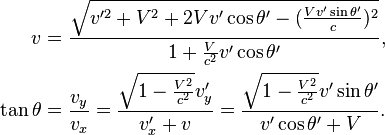





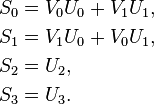
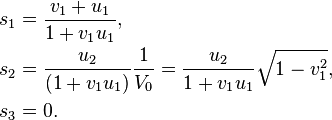






![\mathbf{v} = \mathbf v_\parallel + \mathbf v_\perp = \frac{1}{1+\frac{\mathbf{V}\cdot\mathbf{v}'}{c^{2}}}\left[\alpha_V\mathbf{v}'+ \mathbf{V} + (1-\alpha_V)\frac{(\mathbf{V}\cdot\mathbf{v}')}{V^{2}}\mathbf{V}\right] \equiv \mathbf V \oplus \mathbf v',](../I/m/18ae79921e427d85d24d5aa0ea26401c.png)
![\begin{align}\mathbf u \oplus \mathbf v
&=\frac{1}{1 + \frac{\mathbf u \cdot \mathbf v}{c^2}}\left[\mathbf u +
\frac{\mathbf v}{\gamma_u} +
\frac{1}{c^2}\frac{\gamma_u}{1+\gamma_u}(\mathbf u \cdot \mathbf v)\mathbf u\right]\\
&= \frac{1}{1 + \frac{\mathbf u \cdot \mathbf v}{c^2}}\left[\mathbf u + \mathbf v +
\frac{1}{c^2}\frac{\gamma_u}{1+\gamma_u} \mathbf u \times(\mathbf u \times \mathbf v)\right],\end{align}](../I/m/2bb8db07747348d6b0f108fa9f7bf366.png)




![|\mathbf u \oplus \mathbf v|^2 = \frac{1}{\left(1+\frac{\mathbf u \cdot \mathbf v}{c^2}\right)^2}\left[\left(\mathbf u + \mathbf v \right)^2 - \frac{1}{c^2}\left(\mathbf u \times \mathbf v\right)^2 \right] = |\mathbf v \oplus \mathbf u|^2.](../I/m/2a66346c1856a01d19be0639ac7fd428.png)
![\begin{align}\left(1+\frac{\mathbf u \cdot \mathbf v}{c^2}\right)^2|\mathbf u \oplus \mathbf v|^2 &= \left[ \mathbf u + \mathbf v + \frac{1}{c^2}\frac{\gamma_u}{1+\gamma_u}\mathbf u \times(\mathbf u \times \mathbf v)\right]^2\\
&=(\mathbf u + \mathbf v)^2 +2\frac{1}{c^2} \frac{\gamma_u}{\gamma_u + 1} \left[(\mathbf u \cdot \mathbf v)^2-(\mathbf u\cdot\mathbf u)(\mathbf v\cdot\mathbf v)\right] + \frac{1}{c^4}\left(\frac{\gamma_u}{\gamma_u + 1}\right)^2\left[(\mathbf u\cdot\mathbf u)^2(\mathbf v \cdot \mathbf v) - (\mathbf u\cdot \mathbf v)^2(\mathbf u\cdot \mathbf u)\right]\\
&=(\mathbf u + \mathbf v)^2 +2\frac{1}{c^2} \frac{\gamma_u}{\gamma_u + 1} \left[(\mathbf u \cdot \mathbf v)^2-(\mathbf u\cdot\mathbf u)(\mathbf v\cdot\mathbf v)\right]
+ \frac{u^2}{c^4}\left(\frac{\gamma_u}{\gamma_u + 1}\right)^2\left[(\mathbf u\cdot\mathbf u)(\mathbf v \cdot \mathbf v) - (\mathbf u\cdot \mathbf v)^2\right]\\
&=(\mathbf u + \mathbf v)^2 +2\frac{1}{c^2} \frac{\gamma_u}{\gamma_u + 1} \left[(\mathbf u \cdot \mathbf v)^2-(\mathbf u\cdot\mathbf u)(\mathbf v\cdot\mathbf v)\right]
+ \frac{(1-\alpha_u)(1+\alpha_u)}{c^2}\left(\frac{\gamma_u}{\gamma_u + 1}\right)^2\left[(\mathbf u\cdot\mathbf u)(\mathbf v \cdot \mathbf v) - (\mathbf u\cdot \mathbf v)^2\right]\\
&=(\mathbf u + \mathbf v)^2 +2\frac{1}{c^2} \frac{\gamma_u}{\gamma_u + 1} \left[(\mathbf u \cdot \mathbf v)^2-(\mathbf u\cdot\mathbf u)(\mathbf v\cdot\mathbf v)\right]
+ \frac{(\gamma_u-1)}{c^2(\gamma_u + 1)}\left[(\mathbf u\cdot\mathbf u)(\mathbf v \cdot \mathbf v) - (\mathbf u\cdot \mathbf v)^2\right]\\
&=(\mathbf u + \mathbf v)^2 +2\frac{1}{c^2} \frac{\gamma_u}{\gamma_u + 1} \left[(\mathbf u \cdot \mathbf v)^2-(\mathbf u\cdot\mathbf u)(\mathbf v\cdot\mathbf v)\right]
+ \frac{(1-\gamma_u)}{c^2(\gamma_u + 1)}\left[(\mathbf u\cdot \mathbf v)^2 - (\mathbf u\cdot\mathbf u)(\mathbf v \cdot \mathbf v)\right]\\
&=(\mathbf u + \mathbf v)^2 +\frac{1}{c^2} \frac{\gamma_u+1}{\gamma_u + 1} \left[(\mathbf u \cdot \mathbf v)^2-(\mathbf u\cdot\mathbf u)(\mathbf v\cdot\mathbf v)\right]\\
&=(\mathbf u + \mathbf v)^2 -\frac{1}{c^2} |\mathbf u \times \mathbf v|^2
\end{align}](../I/m/3ccc3e6919976507a1b2d6c3e8705039.png)
![\gamma_{\mathbf u \oplus \mathbf v} =\left[ 1 - \frac{1}{c^2}\frac{1}{(1+\frac{\mathbf u \cdot \mathbf v}{c^2})^2}
\left( (\mathbf u + \mathbf v)^2 - \frac{1}{c^2}(u^2v^2 - (\mathbf u \cdot \mathbf v)^2)\right)\right]^{-\frac{1}{2}}=\gamma_u\gamma_v\left(1+\frac{\mathbf u \cdot \mathbf v}{c^2}\right).](../I/m/63857a4b8177aa572d334e70f05dde09.png)
![\begin{align}\gamma_{\mathbf u \oplus \mathbf v} &= \left[ \frac{c^2(1+\frac{\mathbf u \cdot \mathbf v}{c^2})^2}{c^2(1+\frac{\mathbf u \cdot \mathbf v}{c^2})^2}
- \frac{1}{c^2}\frac{ (\mathbf u + \mathbf v)^2 - \frac{1}{c^2}(u^2v^2 - (\mathbf u \cdot \mathbf v)^2)}{(1+\frac{\mathbf u \cdot \mathbf v}{c^2})^2}\right]^{-\frac{1}{2}}\\
&=\left[ \frac{c^2(1+\frac{\mathbf u \cdot \mathbf v}{c^2})^2 - (\mathbf u + \mathbf v)^2 + \frac{1}{c^2}(u^2v^2 - (\mathbf u \cdot \mathbf v)^2)}{c^2(1+\frac{\mathbf u \cdot \mathbf v}{c^2})^2}
\right]^{-\frac{1}{2}}\\
&=\left[ \frac{c^2(1+2\frac{\mathbf u \cdot \mathbf v}{c^2} + \frac{(\mathbf u \cdot \mathbf v)^2}{c^4}) - u^2 - v^2 - 2(\mathbf u \cdot \mathbf v) + \frac{1}{c^2}(u^2v^2 - (\mathbf u \cdot \mathbf v)^2)}{c^2(1+\frac{\mathbf u \cdot \mathbf v}{c^2})^2}
\right]^{-\frac{1}{2}}\\
&=\left[ \frac{1+2\frac{\mathbf u \cdot \mathbf v}{c^2} + \frac{(\mathbf u \cdot \mathbf v)^2}{c^4} - \frac{u^2}{c^2} - \frac{v^2}{c^2} - \frac{2}{c^2}(\mathbf u \cdot \mathbf v) + \frac{1}{c^4}(u^2v^2 - (\mathbf u \cdot \mathbf v)^2)}{(1+\frac{\mathbf u \cdot \mathbf v}{c^2})^2}
\right]^{-\frac{1}{2}}\\
&=\left[ \frac{1 + \frac{(\mathbf u \cdot \mathbf v)^2}{c^4} - \frac{u^2}{c^2} - \frac{v^2}{c^2} + \frac{1}{c^4}(u^2v^2 - (\mathbf u \cdot \mathbf v)^2)}{(1+\frac{\mathbf u \cdot \mathbf v}{c^2})^2}
\right]^{-\frac{1}{2}}\\
&=\left[ \frac{(1-\frac{u^2}{c^2})(1-\frac{v^2}{c^2})}{(1+\frac{\mathbf u \cdot \mathbf v}{c^2})^2}
\right]^{-\frac{1}{2}}\\
&=\left[ \frac{1}{\gamma_u^2\gamma_v^2(1+\frac{\mathbf u \cdot \mathbf v}{c^2})^2}
\right]^{-\frac{1}{2}}\\
&=\gamma_u\gamma_v(1+\frac{\mathbf u \cdot \mathbf v}{c^2})\end{align}](../I/m/401baded7ee91e1016ba1941246b50e3.png)
![\boldsymbol{\beta}_u\oplus\boldsymbol{\beta}_v=\frac{1}{1+\boldsymbol{\beta}_u\cdot\boldsymbol{\beta}_v }\left[\boldsymbol{\beta}_u+\frac{\boldsymbol{\beta}_v}{\gamma_u}+\frac{\gamma_u}{\gamma_u+1}(\boldsymbol{\beta}_v\cdot\boldsymbol{\beta}_u)\boldsymbol{\beta}_u\right]](../I/m/77da55db7ce38af7bef6dea93b93c4b3.png)
![\mathbf{u}\oplus\mathbf{v} = \frac{1}{1+\frac{\mathbf{u}\cdot\mathbf{v}}{c^2}}\left[\mathbf{v}+\mathbf{u}+\frac{1}{c^2}\frac{\gamma_\mathbf{u}}{\gamma_\mathbf{u}+1}\mathbf{u}\times(\mathbf{u}\times\mathbf{v})\right]](../I/m/7a1a80d0a56f659495913cf1bd33c667.png)
![\mathbf{u}*\mathbf{v}=\frac{1}{1+\frac{\mathbf{u}\cdot\mathbf{v}}{c^2}}\left[\mathbf{v}+\mathbf{u}+\frac{1}{c^2}\frac{\gamma_\mathbf{u}}{\gamma_\mathbf{u}+1}\mathbf{u}\times(\mathbf{u}\times\mathbf{v})\right]](../I/m/55c7c895db57c76d501446aa9f9536d6.png)
![\mathbf{v}\circ\mathbf{u}=\frac{1}{1+\frac{\mathbf{u}\cdot\mathbf{v}}{c^{2}}}\left[\frac{\mathbf{v}}{\gamma_\mathbf{u}}+\mathbf{u}+\frac{1}{c^{2}}\frac{\gamma_\mathbf{u}}{\gamma_\mathbf{u}+1}(\mathbf{v}\cdot\mathbf{u})\mathbf{u}\right]](../I/m/1222f8d111f4bde9b44c55af1b6edd15.png)




